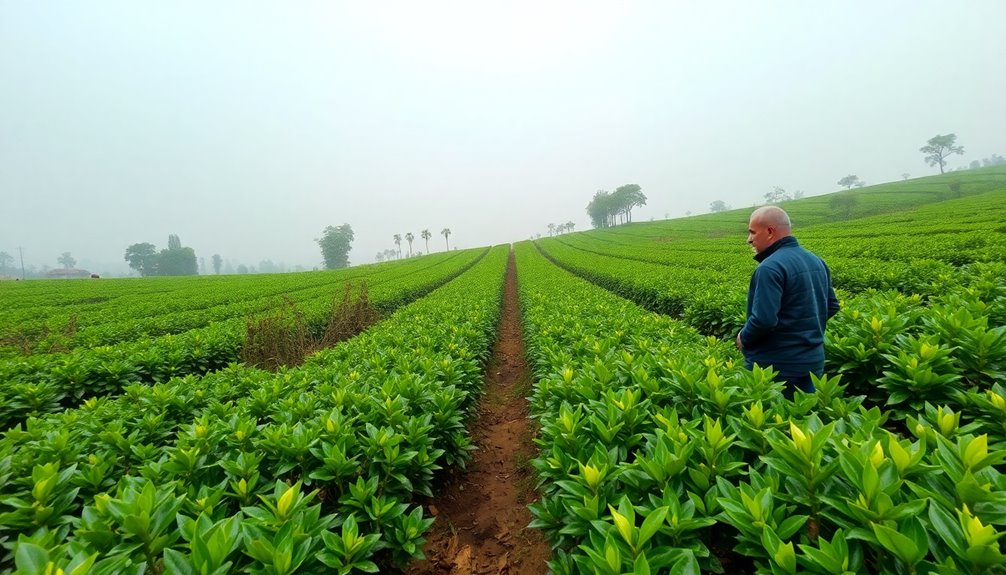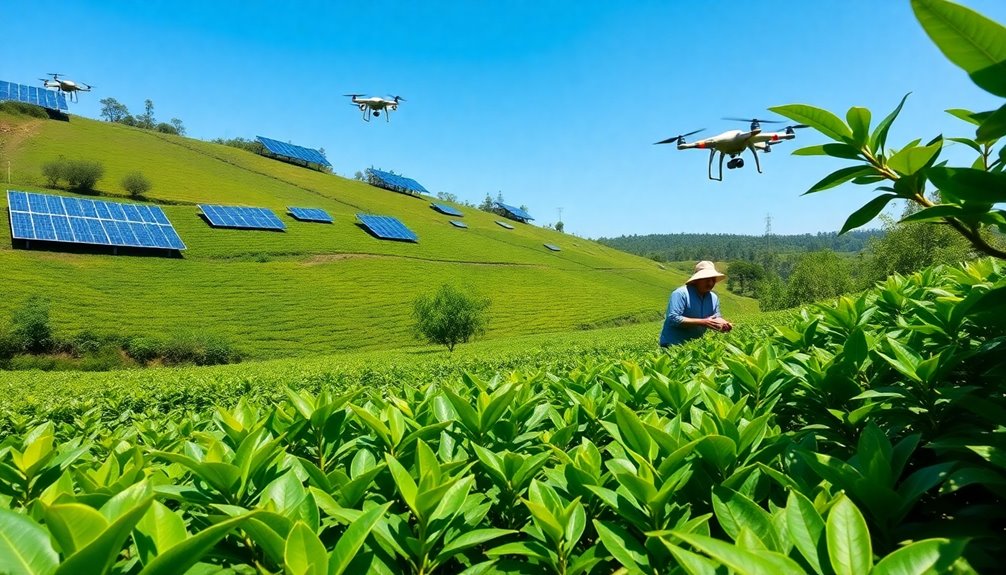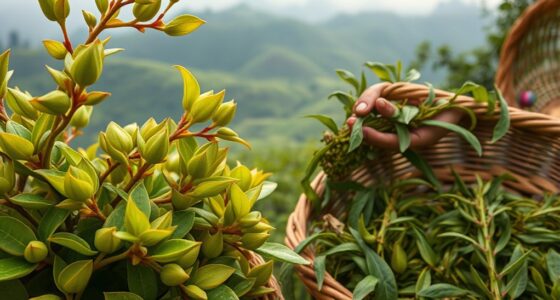Climate change is shaking up tea harvests all around the globe. Rising temperatures make it tough for tea plants, often causing bitter leaves and pests to thrive. Meanwhile, changing rainfall patterns can wash away soil or leave plants thirsty, which weakens them. You might notice that the flavors of your favorite teas are changing, too! Sometimes the taste gets sweeter, but extreme weather can dull it. Plus, harsh conditions make it hard for workers to stay in the fields, leading to fewer hands to help. With all these changes, farmers are finding smart solutions. Keep exploring to discover how they're facing these challenges!
Key Takeaways
- Rising temperatures disrupt optimal growth conditions for tea, leading to bitter leaves and increased pest risks.
- Altered rainfall patterns cause soil erosion and weak tea plants, affecting harvest quality and quantity.
- Climate change influences tea flavor profiles, resulting in both enhanced sweetness and dulled tastes.
- Extreme weather conditions contribute to labor shortages, reducing production capacity and increasing tea prices.
- Adopting sustainable practices and new cultivation techniques is vital for mitigating climate impacts on tea harvests.
Introduction
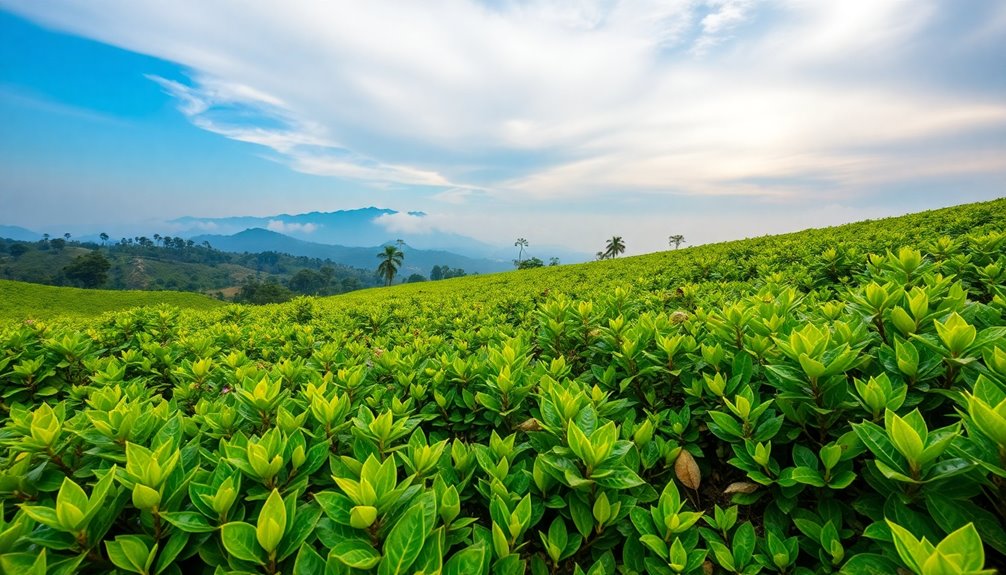
Climate change is reshaping the landscape of tea production around the globe. You mightn't think about it, but tea—one of the world's favorite drinks—depends on specific weather conditions. Farmers need just the right amount of rain and sunshine to grow healthy tea plants. As temperatures rise and weather patterns change, it can make growing tea a real challenge.
Imagine walking through lush green tea fields, where the scent of fresh leaves fills the air. It's a beautiful sight, but climate change is putting that beauty at risk. Farmers are worried about how these changes will affect their harvests. They're watching the skies closely, hoping for good weather.
You may wonder how this impacts you. Well, when tea production is affected, it could mean less tea available for everyone. Higher prices at your favorite café might follow.
Rising Temperatures Affect Tea Yield

As temperatures rise, tea yields are increasingly at risk. You might wonder how that happens. Well, tea plants thrive in specific temperature ranges, usually between 20°C and 30°C. When it gets too hot, these plants struggle to grow. Imagine being outside on a hot day without any shade—it's tough, right?
When the heat is on, tea leaves can become bitter and lose their flavor. This means that the tea you love mightn't taste as good!
Plus, high temperatures can lead to pests and diseases that harm the plants. If pests invade, farmers have to use more chemicals, which isn't great for the environment.
Farmers around the world are noticing these changes. They're trying to adapt by planting new tea varieties that can handle the heat better. Some even experiment with different growing methods.
But these changes take time, and not every farmer can keep up.
Altered Rainfall Patterns Disrupt Harvests
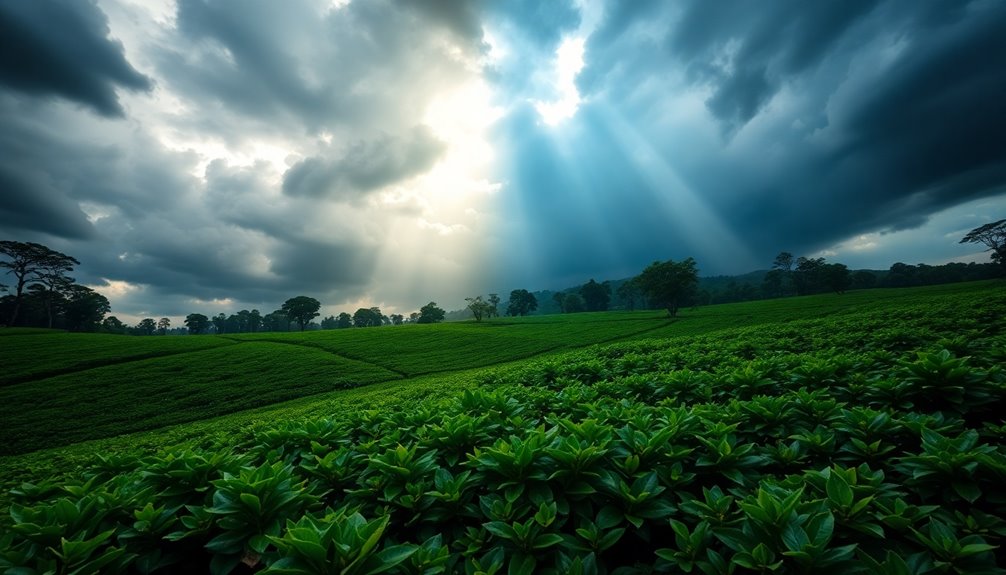
With shifting weather patterns, altered rainfall is causing significant disruptions to tea harvests. You mightn't think about it, but tea plants really rely on the right amount of rain. When it rains too much or too little, it can hurt the plants and affect how much tea is picked. Imagine a garden where some plants are flooded while others are drying out!
Farmers are facing challenges as they try to adapt to these changes. If there's too much rain, the soil can wash away, and tea leaves might get damaged. On the other hand, when there's not enough rain, the plants can't grow strong and healthy. This makes it hard for farmers to plan their harvests.
In places like India and Sri Lanka, where tea is a big deal, these changes are especially concerning. You can see how important it's for farmers to keep an eye on the weather. They must find new ways to care for their tea plants.
With each season bringing surprises, they need to be ready for anything. The future of tea depends on how well they can adapt to these altered rainfall patterns!
Shifts in Tea Flavor Profiles
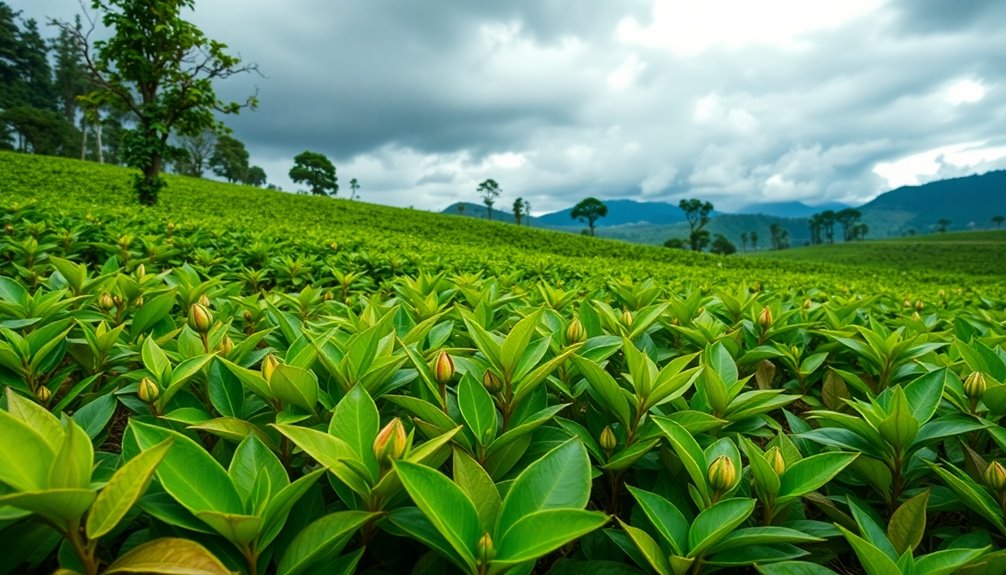
Recent changes in weather patterns are altering the flavor profiles of tea, and you might be surprised by how much this affects your favorite brews. As temperatures rise and rainfall shifts, the way tea plants grow changes too. This means that the flavors you love could taste a bit different than before.
For example, warmer weather can cause tea leaves to develop more sweetness. You might notice a richer taste in your cup! On the other hand, too much heat or rain can lead to a less vibrant flavor. If there's not enough sunlight, the tea might taste a bit dull. Isn't it amazing how weather can change something as simple as a cup of tea?
Different regions are also affected in unique ways. Tea from one area might become more floral, while another might taste earthier. These shifts can make your tea-drinking experience exciting and new!
You may find yourself discovering new favorites or enjoying familiar ones in a whole new way. So, the next time you sip your tea, remember that climate change is playing a role in those delightful flavors. Enjoy the journey of taste!
Labor Shortages in Tea Production

While climate change impacts tea flavor profiles, it also contributes to significant labor shortages in tea production. You might wonder how this happens. Well, as temperatures rise and weather patterns change, many tea workers face tougher working conditions. Extreme heat and unpredictable rainfall can make it hard for them to do their jobs comfortably. Some workers might even leave the fields for safer, cooler jobs elsewhere.
The tea industry relies heavily on seasonal workers, who usually come from nearby communities. But when climate change disrupts local climates, fewer people are willing or able to work in the tea fields. This means fewer hands to pick the tea leaves, which can lead to lower production overall.
You can see how this creates a cycle of challenges. With fewer workers, tea farmers struggle to meet growing demand, which may lead to higher prices. It's a big problem for tea lovers everywhere!
As these labor shortages continue, it's important to support sustainable practices that can help protect both workers and the environment. Together, we can enjoy delicious tea while being mindful of the challenges it faces.
Practical Applications
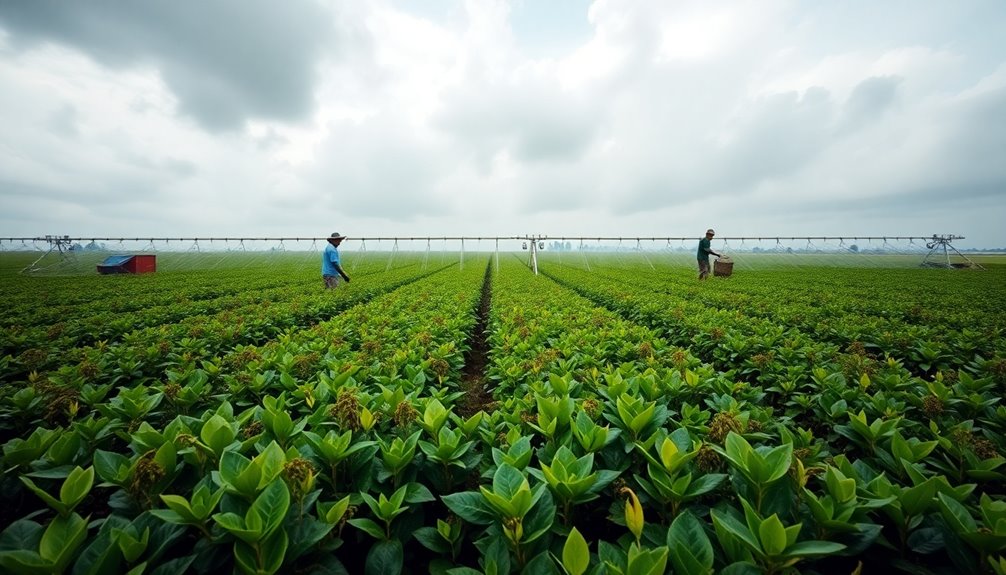
As we navigate the challenges posed by climate change on tea harvests, it's crucial to explore practical applications that can help mitigate these issues.
One exciting approach is to use technology, like weather forecasting tools, which can help farmers predict changes in climate and plan their harvests better. Imagine checking your phone to see the best time to pick those delicious leaves!
Another great idea is planting new tea varieties that can withstand warmer temperatures. By choosing these hardier plants, you can ensure a steady supply of tea, even in changing conditions.
Plus, don't forget about water conservation! Implementing drip irrigation systems can save water and keep plants healthy, helping them thrive even during dry spells.
Frequently Asked Questions
How Does Climate Change Affect Tea Quality Over Time?
Climate change can really change tea quality over time!
As temperatures rise and rainfall patterns shift, the flavors of tea can change too. You might notice that teas grown in warmer areas taste different than before.
Heat can also affect how plants grow, impacting their color and aroma. Plus, pests thrive in warmer weather, which can harm the plants.
Are Certain Tea Varieties More Resilient to Climate Change?
Absolutely! Some tea varieties are indeed more resilient to climate change.
For instance, certain types like Assam and Darjeeling can handle heat better than others. They adapt well to changing weather patterns.
This means they might still thrive even when conditions get tough. Isn't that exciting?
What Regions Are Most Vulnerable to Tea Production Decline?
When you think about tea, some regions pop up as more vulnerable to production decline.
Areas like Assam in India, and parts of Sri Lanka, are really at risk. They face rising temperatures and unpredictable weather patterns.
These changes can hurt the tea plants and reduce the quality of the leaves.
It's important to protect these regions, so we can keep enjoying our favorite cup of tea for years to come!
How Can Consumers Support Sustainable Tea Farming Practices?
You can support sustainable tea farming practices by choosing teas labeled as organic or fair trade.
These labels mean farmers use eco-friendly methods and fair wages. You could also buy from local shops or brands that prioritize sustainability. Every cup you enjoy can help!
Additionally, spreading the word about sustainable tea choices encourages others to make wise decisions too. Together, your choices can create a positive impact on the planet and tea farmers!
What Role Does Technology Play in Adapting Tea Farming?
Technology plays a big role in helping tea farmers adapt!
You'll find farmers using drones to monitor their crops, making it easier to spot issues early. Smart sensors help them manage water and nutrients more efficiently.
Plus, mobile apps connect them with experts for advice. With these tools, farmers can grow healthier tea and reduce waste.
Isn't it amazing how technology can help create a better future for tea farming?
Conclusion
In conclusion, climate change is shaking up tea harvests around the world! Rising temperatures, changing rain patterns, and even labor shortages are all making it tricky for farmers. But there's hope! By learning about these challenges, we can appreciate our favorite tea even more. Every cup tells a story, connecting us to the farmers working hard to bring it to our tables. So, let's sip our tea with joy and be mindful of how it gets there!

